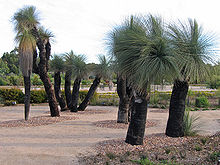Dasypogonaceae
Appearance
| Dasypogonaceae | |
|---|---|

| |
| Kingia australis in the Royal Botanic Gardens, Cranbourne | |
| Scientific classification | |
| Kingdom: | Plantae |
| Clade: | Tracheophytes |
| Clade: | Angiosperms |
| Clade: | Monocots |
| Clade: | Commelinids |
| Order: | Arecales |
| Family: | Dasypogonaceae Dumort. |
| Genera | |
| |
Dasypogonaceae is a family of flowering plants. Such a family has not been commonly recognized by taxonomists: the plants involved were usually included in the family Xanthorrhoeaceae. Dasypogonaceae includes four genera with 16 species.[1]
The APG IV system, of 2016 places the family in order Arecales, after some studies revealed the family as sister to Arecaceae.[2]
The earlier APG III of 2009, APG II of 2003, and APG system of 1998, accepted the family and assigns the family to the clade commelinids, unplaced as to order.[3] In turn, the commelinids belong to the monocots.
The family is endemic to Australia, and comprises 16 species in four genera. The best known representative is Kingia australis.
References
- ^ Christenhusz, M. J. M.; Byng, J. W. (2016). "The number of known plants species in the world and its annual increase". Phytotaxa. 261 (3): 201–217. doi:10.11646/phytotaxa.261.3.1.
- ^ Angiosperm Phylogeny Group (2016). "An update of the Angiosperm Phylogeny Group classification for the orders and families of flowering plants: APG IV". Botanical Journal of the Linnean Society. 181 (1): 1–20. doi:10.1111/boj.12385.
- ^ Angiosperm Phylogeny Group (2009). "An update of the Angiosperm Phylogeny Group classification for the orders and families of flowering plants: APG III". Botanical Journal of the Linnean Society. 161 (2): 105–121. doi:10.1111/j.1095-8339.2009.00996.x. Archived from the original (PDF) on 2017-05-25. Retrieved 2013-06-26.
External links
Wikispecies has information related to Dasypogonaceae.
- Dasypogonaceae, Calectasiaceae in L. Watson and M.J. Dallwitz (1992 onwards). The families of flowering plants: descriptions, illustrations, identification, information retrieval. Version: 9 March 2006. https://web.archive.org/web/20070103200438/http://delta-intkey.com/.
- Dasypogonaceae in Western Australia [70 entries]
